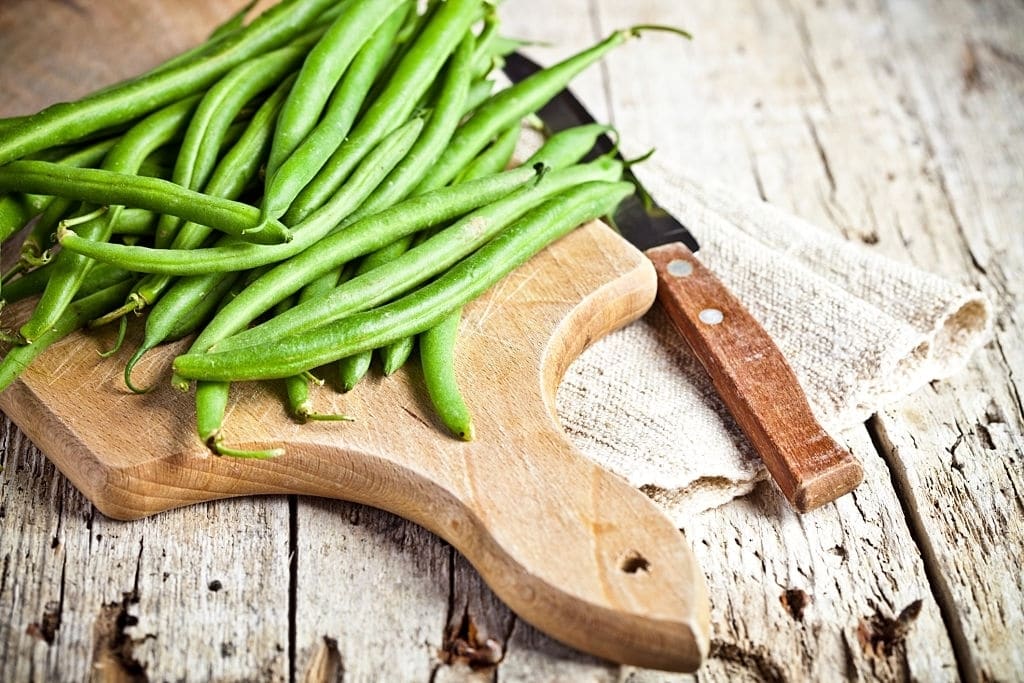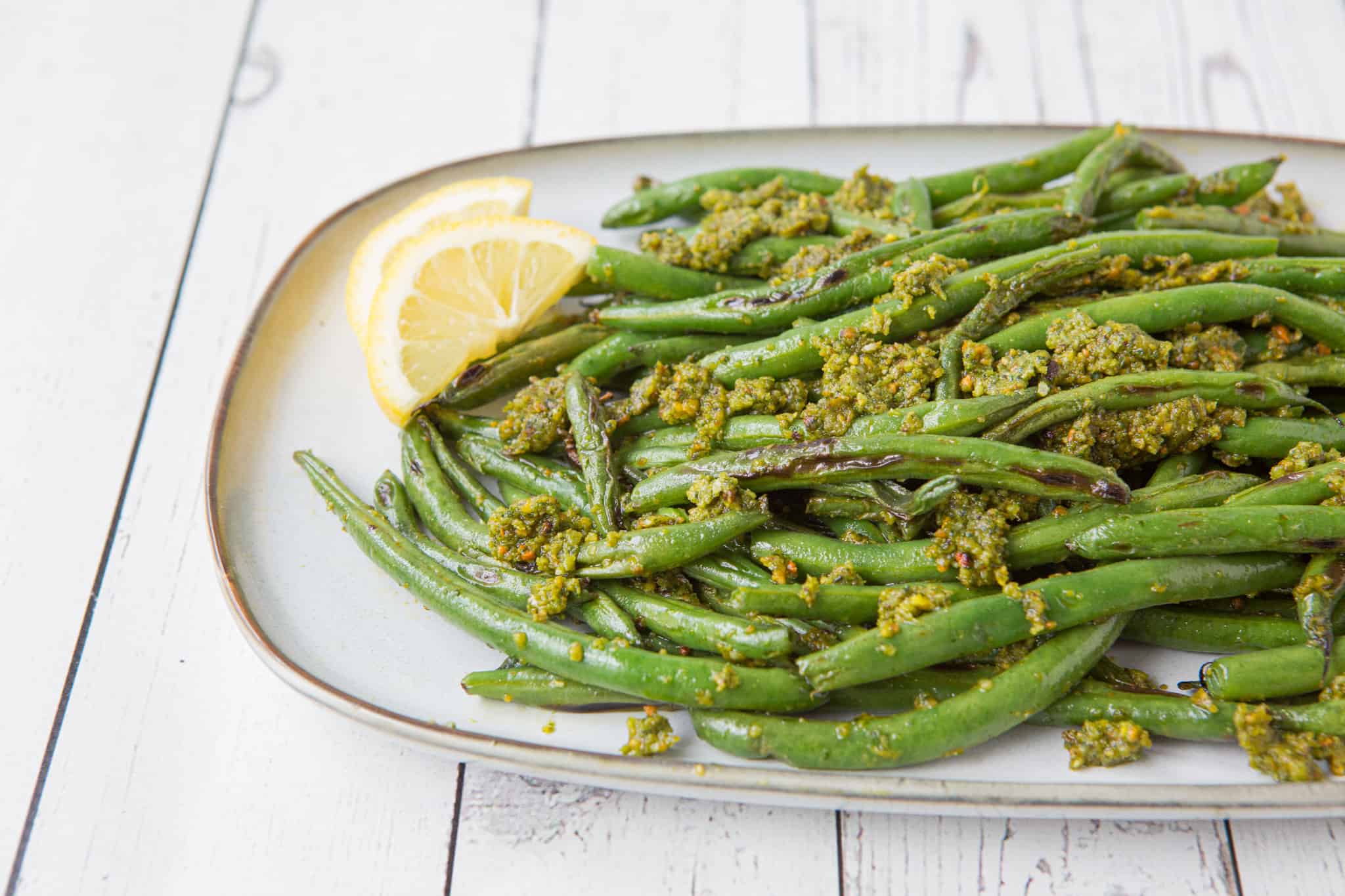You have fresh green beans in the fridge for tonight’s dinner, but when you take them out, they look like they’re going bad. How can you tell if your green beans are no longer safe to eat?
It’s not always easy to remember when we brought home that bunch of fresh green beans from the store, but there are some signs to keep an eye out for. First, take a look at the color of your raw green beans. Because they should be bright green, if they’ve lost that color, that’s a bad sign. There are a few brown spots on them, which means they are getting old, but they are still safe to eat.
Another visual cue for signs of bad green beans is simply their texture. Fresh green beans in good condition will feel firm and should snap apart when bent. Green beans that are too old, feel limp, and have started to get slimy are no longer safe to eat. If you see any fuzzy mold on them, they are definitely too bad to eat.
It’s another sign of old beans that the shapes of the seeds look like they’re coming out of the shell. Some kinds of green beans may have an “off smell” when they’re bad, but not all different kinds do.
It’s disheartening to open your veggie drawer expecting fresh, crunchy green beans only to find them coated in a slimy film. This unappetizing goo can prompt the question – why did my green beans get slimy and what should I do about it?
In this article we’ll explore the common culprits behind slimy green beans, which situations can be remedied safety precautions, and tips to prevent it from happening in the future. Let’s dive in to demystify the dreaded slimy bean phenomenon.
Overview of the 2 Main Causes of Slimy Green Beans
Before digging into solutions, it’s important to understand what causes green beans to become coated in slick, gooey slime in the first place. There are two primary reasons this can occur:
1. Bacterial Growth Due to Spoilage
The most common reason for slimy green beans is bacterial growth due to spoilage over time As beans sit in your fridge past their prime, naturally occurring bacteria feed on the vegetable matter and multiply The byproduct of this bacterial proliferation is a biofilm that manifests as a wet, slimy residue.
2. Excess Release of Pectin During Cooking
The other potential cause of slime on green beans applies to cooked beans especially those boiled steamed, or blanched too long. Overcooking can cause the vegetable’s pectin (a water-soluble carbohydrate) to break down and leach out, leaving a slippery coating on the exterior.
Can Slimy Raw Green Beans Be Salvaged?
If your raw green beans are covered in slime, the unfortunate answer is that they cannot be safely washed and eaten.
The slimy substance comes from bacteria such as lactobacillus, klebsiella, and pseudomonas that have multiplied and produced biofilm as the beans decay. This bacteria has likely penetrated into the vegetable, so surface washing cannot remove the contamination.
Consuming slimy raw green beans can cause foodborne illness, with symptoms like:
- Nausea and vomiting
- Abdominal cramps
- Diarrhea
- Fever
- Chills
- Headache
The severity depends on the specific bacteria present and amount ingested, but it’s better to be safe than sorry when it comes to slime. Always discard raw green beans at the first sign of slime rather than trying to salvage them.
Is It Safe to Eat Cooked Slimy Green Beans?
If your green beans developed a slimy coating only after being cooked via boiling, steaming, or blanching, the slime is harmless and the beans are OK to eat.
Unlike raw beans where slime indicates spoilage, on cooked green beans it is simply excess pectin released from the vegetable fibers during overcooking.
Pectin is a water-soluble fiber found naturally in fruits and veggies like green beans. Long cooking times can cause it to dissolve out of the plant cells into the surrounding liquid.
While not unhealthy, the slimy pectin coating may make the beans less visually appealing. Here are some tips for saving overcooked slimy green beans:
- Rinse under cool running water to wash off exterior slime.
- Pat dry with paper towels to remove excess moisture.
- Quickly pan fry beans in butter or oil to evaporate remaining wetness.
- Pair beans with strongly flavored sauces and seasonings to mask texture.
- Blend beans into dips, purees, or casseroles to disguise sliminess.
However, take care to consume the salvaged beans immediately and do not store them covered in slime.
Proper Precautions for Handling Slimy Green Beans
To prevent illness when dealing with slimy green beans, keep these food safety guidelines in mind:
-
Don’t taste test – Never sample raw or cooked beans with slime to assess if they are OK. Only lab testing could confirm safety.
-
Avoid contact – Raw slimy bean slime could contain pathogenic bacteria. Avoid direct hand contact by using utensils to handle.
-
Don’t cross-contaminate – Properly sanitize any surfaces, utensils, and cutting boards that contact slimy raw beans to prevent bacterial transfer.
-
Monitor for symptoms – If you do accidentally ingest slimy raw beans, monitor carefully for gastrointestinal symptoms for at least 72 hours.
By taking proper precautions, you can safely handle and dispose of spoiled slimy beans without contracting illness.
8 Tips to Prevent Your Green Beans From Getting Slimy
Avoiding slime in the first place is the ideal solution. Here are tips for keeping your green beans fresh and crisp:
-
Buy high-quality beans – Select vibrant, firm beans without brown spots or blemishes. Avoid cans with bulges or dents.
-
Use beans quickly – Prepare beans within 2-3 days of purchasing for maximum freshness.
-
Store properly – Keep raw beans unwashed in perforated plastic bags in the crisper drawer set to high humidity.
-
Monitor closely – Check beans daily and use immediately at any sign of deterioration like softening or discoloration.
-
Cook beans correctly – Follow tested recipes and cooking times to prevent overcooking beans into slime.
-
Cool cooked beans quickly – Plunge blanched or steamed beans into ice baths to halt cooking and pectin breakdown.
-
Use preserved beans – Opt for frozen or canned beans if you won’t use fresh beans promptly.
-
Sanitize surfaces and utensils – Prevent cross-contamination with proper cleaning habits.
With attentive storage, handling, and preparation, you can enjoy green beans in all their non-slimy glory.
Frequently Asked Questions About Slimy Green Beans
Here are answers to some common FAQs about managing slimy beans:
Why did my cooked frozen green beans get slimy?
Overcooking frozen beans can cause excess pectin release. Try reducing cooking times by a few minutes.
What causes some beans to be slimier than others when cooked?
Higher pectin varieties like snap beans are more prone to sliming. Lima and pole beans have less pectin.
Is it possible to wash bacteria off raw slimy beans?
No, bacteria penetrates below the surface so washing cannot remove the contamination.
Can I scrape the slime off cooked beans to eat them?
Scraping may remove exterior slime, but overcooked texture and flavor defects will remain. It’s better to disguise sliminess.
Should I rinse canned beans that have a slimy sauce?
Yes, drain and thoroughly rinse canned beans before use to remove unhealthy coating slime.
Why do my steamed beans get slimier the longer I let them sit after cooking?
Pectin will continue leaching out of cooked beans into the surrounding moisture if not promptly eaten or cooled.
The Takeaway on Managing Slimy Green Beans
If you’ve ever been perplexed by the sudden sliminess of green beans, whether raw or cooked, this guide provides insight into the common causes and which situations can be remedied safely.
While raw slimy beans sadly must be discarded, overly cooked slimy beans can be refreshed and consumed. Most importantly, following proper storage and handling methods can help you avoid the off-putting slime in the first place.
With an understanding of what makes beans slimy and how to mitigate it, you can confidently keep these healthy legumes in your regular vegetable rotation. Just be vigilant about monitoring for freshness and don’t hesitate to compost them at the first signs of trouble.

Shelf Life of Green Beans
Some other names for French beans are string beans and haricots verts. They usually last 5 to 7 days in the vegetable drawer of the fridge if they are stored in a plastic bag or an airtight container. Green beans that haven’t been washed or snapped can be kept at room temperature in a dry place, but the fridge is where they should be kept. Freezing blanched green beans is also a good option. To blanch a green bean follow these steps:
- Trim the stem end of the beans and discard.
- Place the green beans in boiling water. It will only take about two minutes for small beans and three to four minutes for large beans.
- Let the beans cool down in ice water for a while, then drain them on kitchen towels or paper towels. This ice bath stops the cooking process.
- Place the beans in freezer bags or a freezer-safe container. Put the date on the bag and keep it flat in the freezer.
For the best quality, use these frozen beans within 8 months.
It’s worth the work to grow this popular vegetable because it’s full of protein and fiber, which help lower cholesterol. Fiber really is an amazing nutrient. It does so many cool things in our bodies like:
- Keep you full and satisfied.
- Lower cholesterol.
- Help maintain a healthy weight.
- Aid in the bodys natural detoxification system.
- Perhaps lower colon cancer risk.
Fiber may also help lower your risk of getting breast cancer. You can learn more about this in my article on How to Eat More Fiber.
Green beans are a good source of folate and potassium, and vitamins K, A, and C. Don’t eat canned green beans or cook them the same way you always have. Try my recipe for Grilled Green Beans with Pistachio Pesto instead.

This recipe is very simple to make, and you can even use store-bought pesto instead of making your own. The best part is that grilling them means less dishes for you to clean up later. When you have family over, green beans are always a hit, so it makes sense to grill them along with whatever else you’re serving.
You can also roast green beans in olive oil, cook them in the air fryer, or put them in a classic casserole.
